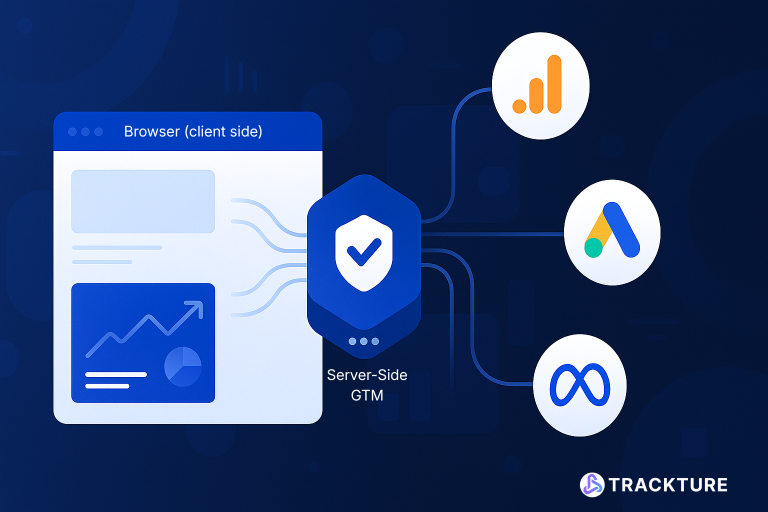What Server-Side Tagging Really Means for Marketers in 2025
Introduction: A New Era of Data Collection
For the past decade, marketers relied on client-side tags — scripts running directly in a visitor’s browser — to collect analytics, conversions, and remarketing data. But in 2025, that approach is reaching its limits. Browser restrictions, ad blockers, privacy regulations, and unreliable cookie consent all make client-side tracking increasingly fragile.
Server-side tagging (sGTM) represents the next evolution. Instead of sending tracking data directly from the browser to vendors like Google or Meta, server-side tagging routes it through a secure, first-party server that you control. This small architectural shift changes everything: data accuracy, compliance, and control.
What Is Server-Side Tagging?
Server-side tagging means that your tracking setup moves from the user’s browser into a secure environment — usually Google Tag Manager Server-Side (sGTM), hosted on your domain or a cloud platform like Google Cloud or Stape.
In a traditional setup:
Browser → multiple third-party servers (Google, Meta, LinkedIn, etc.)
In a server-side setup:
Browser → your server container → destination platforms
The result is fewer client-side scripts, faster page loads, and cleaner, more reliable data flow.
Why It Matters in 2025
1. Privacy Compliance Becomes Default
Regulations like GDPR, CCPA, and ePrivacy now require explicit user consent before tracking. Server-side tagging allows you to integrate Consent Mode v2 and anonymization logic at the server level — ensuring no personal data is sent without consent.
2. Data Accuracy and Signal Loss Recovery
Browser limitations and cookie blocking (especially from Safari and Firefox) cause lost conversions and inconsistent data. With server-side tracking, you regain up to 30% more attributed conversions thanks to first-party cookies and deduplicated events.
3. Full Control Over What Gets Sent
Your server container becomes a “traffic controller.” You decide exactly what user data gets passed to vendors and in what format — protecting sensitive information and aligning with your privacy policy.
4. Improved Site Performance
Every script you remove from the frontend reduces load time and improves Core Web Vitals. Faster pages mean better SEO, user experience, and conversion rates.
How Server-Side Tagging Works (Simplified)
- Browser Event Triggered
A visitor performs an action — e.g., form submission or purchase. - Data Sent to sGTM Endpoint
Instead of firing third-party pixels, the event data is sent to your server container (e.g.,https://track.yourdomain.com). - sGTM Processes the Event
The server parses, cleans, and optionally enriches the data (e.g., hashing user IDs or trimming unnecessary parameters). - Forwarding to Destinations
The processed event is forwarded to GA4, Google Ads, Meta CAPI, or any other platform — all under your control.
This architecture allows you to own your data pipeline and comply with modern privacy standards while preserving marketing performance.
Use Cases for Modern Marketers
|
Use Case |
How sGTM Helps |
|---|---|
|
GA4 + Google Ads Tracking |
Eliminates client-side scripts and uses first-party cookies for better attribution. |
|
Meta Conversion API (CAPI) |
Reduces event loss and improves match quality through hashed identifiers. |
|
LinkedIn Insight Tag Migration |
Moves conversion tracking server-side for B2B leads with stricter privacy policies. |
|
Custom Events (Forms, Sign-ups, Purchases) |
Captured via secure API requests rather than browser-based scripts. |
Privacy-First by Design
At Trackture, we design tagging infrastructure around data minimization — sending only what’s necessary, always respecting user consent, and maintaining full transparency.
Server-side tagging isn’t just about performance; it’s a step toward trust-based marketing infrastructure where compliance and measurement coexist.
Business Benefits
- 30–50% improved data accuracy
- Reduced dependency on third-party cookies
- Better ad platform optimization
- Future-proof compliance
- Improved site speed and user experience
Getting Started
Migrating to server-side tagging involves:
- Auditing your current GTM + GA4 setup
- Deploying a server container (Stape, GCP, or AWS)
- Configuring GA4 + ad platform connections
- Mapping and testing all client events
- Validating consent flow and anonymization
Trackture can manage the full migration — from infrastructure setup to validation — ensuring your data pipeline remains compliant, fast, and accurate.
Conclusion
Server-side tagging isn’t a technical upgrade — it’s a strategic move toward data ownership, compliance, and measurement integrity. As browsers, ad platforms, and privacy laws continue to evolve, the brands that adapt now will own the data advantage in 2025 and beyond.
Ready to modernize your tracking stack?
Let’s make your analytics infrastructure privacy-first and future-proof.


